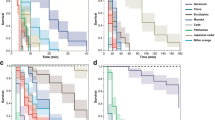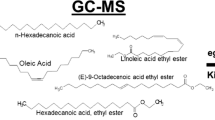Abstract
Natural compounds have been suggested as alternative sources for pediculosis capitis control. We aimed to investigate the chemical composition and evaluate the pediculicidal activity of spearmint, clove, cassia, thyme, eucalyptus, and anise essential oils in addition to sesame oil against human head lice in vitro. A filter paper contact bioassay method was used by applying 0.25 and 0.5 mg/cm2 of each tested oil to filter paper in Petri dishes with 15 females head lice and another with ten nits. The lice mortalities were reported every 5 min for 180 min. The percentage of inhibition of hatch (PIH) was used to calculate ovicidal activity by daily microscopic inspections 5 days after the hatching of controls. Comparison with the widely used pediculicide (malathion) was performed. The most effective essential oil was spearmint followed by cassia and clove with KT50 values of 4.06, 7.62, and 12.12 at 0.5 mg/cm2 and 8.84, 11.38, and 19.73 at 0.25 mg/cm2, respectively. Thyme, eucalyptus, and anise were also effective adulticides with KT50 values of 18.61, 32.65, and 37.34 at 0.5 mg/cm2 and 29.92, 43.16, and 45.37 at 0.25 mg/cm2, respectively. Essential oils were also successful in inhibiting nymph emergence. Spearmint oil was the most effective, with a complete inhibition of emergence at 0.5 mg/cm2. Sesame fixed oil did not show any adulticidal or ovicidal activity against head lice in vitro. The observed insecticidal activity was comparable to malathion. The results herein described the effectiveness of these essential oils as potential pediculicides for head lice control. Incorporation of essential oils in pediculicide formulations needs proper formulation and clinical trials.
Similar content being viewed by others
References
Abdel-Ghaffar F, Semmler M (2007) Efficacy of neem seed extract shampoo on head lice of naturally infected human in Egypt. Parasitol Res 100:329–332
Angioni A, Barra A, Coroneo V, Dessi S, Cabras P (2006) Chemical composition, seasonal variability, and antifungal activity of Lavandula stoechas L. sp. stoechas essential oils from steam/leaves and flowers. J Agric Food Chem 54:4364–4370
Bagavan A, Rahuman AA, Kamaraj C, Elango G, Zahir AA, Jayaseelan C, Santhoshkumar T, Marimuthu S (2011) Contact and fumigant toxicity of hexane flower bud extract of Syzygium aromaticum and its compounds against Pediculus humanus capitis (Phthiraptera: Pediculidae). Parasitol Res 109(5):1329–40
Burgess IF (2004) Human lice and their control. Ann Rev Entomol 49:457–481
Burgess IF, Burgess NA (2011) Dimeticone 4 % liquid gel found to kill all lice and eggs with a single 15 minute application. BMC Res Notes 4:15
Combescot-Lang C, Vander Stichele RH, Toubate B, Veirron E, Mumcuoglu KY (2015) Ex vivo effectiveness of French over-the counter products against head lice (Pediculus humanus capitis De Geer, 1778). Parasitol Res 114:1779–1792
Dambolena J, Zunino M, Rotman A, Ahumada O, Lucini O, Biurrun F, Zygadlo J (2009) Essential oils of plants used in home medicine in North of Argentina. J Essen Oil Res 21:405–409
Dhumal TD, Waghmare JS (2014) Activity of selective different oils against Pediculus humanus capitis. Eur J Biomed Pharm Sci 1(3):306–325
Dhumal TD, Waghmare JS (2015) A pediculicidal activity of clove oil. IJPSR 6(2):857–865
Di Campli ED, Bartolomeo SD, Pizzi PD, Giulio MD, Grande R, Nostro A, Cellini L (2012) Activity of tea tree oil and nerolidol alone or in combination against Pediculus capitis (head lice) and its eggs. Parasitol Res 111:1985–1992
Diamantis SA, Morrell DS, Burkhart CN (2009) Pediatric infestations. Padiatr Ann 38:326–332
Falagas M, Matthaiou D, Rafailidis P, Panos G, Pappas G (2008) Worldwide prevalence of head lice. Emerg Infect Dis 14:1493–1494
Feldmeir H (2012) Pediculosis capitis: new insights into epidemiology, diagnosis and treatment. Eur J Clin Microbiol Infect Dis 9:2105–2110
Frankowski BL, Bocchini JA (2010) Council on school heath and committee on infectious diseases head lice. Pediatrics 126:392–403
Gallardo A, Mougabure-Cueto G, Vassena C, Picollo MI, Toloza AC (2012a) Comparative efficacy of new commercial pedculicides against adults and eggs of Pediculus humanus capitis (head lice). Parasitol Res 110:1601–1606
Gallardo A, Picollo MI, Gonzalez-Audino P, Mougabure-Cueto G (2012b) Insecticidal activity of individual and mixed monoterpenoids of geranium essential oil against. Pediculus humanus capitis (Phthiraptera: Pediculidae). J Med Entomol 49(2):332–335. doi:10.1603/ME11142
Gutiérrez MM, Werdin-González JO, Stefanazzi N, Bras C, Ferrero AA (2016) The potential application of plant essential oils to control Pediculus humanus capitis (Anoplura: Pediculidae). Parasitol Res 115:633–641. doi:10.1007/s00436-015-4781-8
Heukelbach J, Oliverira FA, Speare R (2006a) A new shampoo based on neem (Azadirachta indica) is highly effective against head lice in vitro. Parasitol Res 99:353–356
Heukelbach J, Speare R, Canyon D (2006b). Natural products and their application to the control of head lice: an evidence-based review. In Brahmachari G (ed) Chemistry of natural products: recent trends and development. Chemistry of natural products: recent trends and developments. Kerala, pp 1–26
Heukelbacha J, Canyon D, Speare R (2007) The effect of natural products on head lice: in vitro tests and clinical evidence. J Pediatr Infect Dis 2:1–10
Heukelbach J, Pilger D, Oliveira FA, Khakban A, Ariza L, Feldmeier H (2008) A highly efficacious pediculicide based on dimeticone: randomized observer blinded comparative trial. BMC Infect Dis 8:115
Khater HF (2012) Prospects of botanical biopesticides in insect pest management. Pharmacol 3:641–656
Kosalge SB, Fursule RA (2009) Investigation of licicidal activity of some plants from Satpuda Hills. Int J Pharm Technol Res 1:564–567
Koul O, Suresh W, Dhaliwal GS (2008) Essential oils as green pesticides: potential and constraints. Biopestic Int 4(1):63–84
Kurt Ö, Balcıoğlu C, Emin Limoncu M, Girginkardeşler N, Arserim SK, Görgün S, Oyur T, Karakuş M, Düzyol D, Gökmen AA, Kitapçıoğlu G, Özbel Y (2015) Treatment of head lice (Pediculus humanus capitis) infestation: Is regular combing alone with a special detection comb effective at all levels? Parasitol Res 114:1347–1353
Madke B, Khopkar U (2012) Pediculosis capitis: an update. Indian J Dermatol Venereol Leprol 78:429–438
Mann RS, Kaufmann PE (2012) Natural products pesticides. Their development, delivery and use against insects vectors. Mini Rev Org Chem 9:185–202
Marimuthu S, Rahuman AA, Santhoshkumar T, Jayaseelan C, Kirthi AV, Bagavan A, Kamaraj C, Elango G, Zahir AA, Rajakumar G, Velayutham K (2012) Lousicidal activity of synthesized silver nanoparticles using Lawsonia inermis leaf aqueous extract against Pediculus humanus capitis and Bovicola ovis. Parasitol Res 111:2023–2033
Mondal M, Khalequzzaman M (2010) Toxicity of naturally occurring of plant essential oil against Tribolium castaneum (Herbest). J Biol Sci 10:10–17
Mumcuoglu M, Gilead L, Ingber A (2009) New insights in pediculosis and scabies. Expert Rev Dermotol 4:285–302
Oh JM, Lee IY, Lee WJ, Seo M, Park SA, Lee SH, Seo JH, Youg TS, Shin MH, Pai KS, Yu JR, Sim S (2010) Prevalence of pediculosis capitis among Korean children. Parasitol Res 107:1415–1519
Phillips AK (2009) Toxicity and repellency of essential oils to the German cockroach (Blatella germanica). Tesis Master of Science, Auburn, Alabama. 141 pp
Priestley CM, Burgess IF, Williamson EM (2006) Lethality of essential oil constituents towards the human louse, Pediculus humanus, and its eggs. Fitoterapia 77:303–309
Rassami W, Soonwera M (2013) In vitro pediculicidal activity of herbal shampoo base on Thai local plants against head louse (Pediculus humanus capitis De Geer). Parasitol Res 112:1411–1416
Reddy PJ, Krishna D, Murthy US, Jamil K (1992) A microcomputer Fortran program for rapid determination of lethal concentration of biocides in mosquito control. Comput Appl Biosci 8:209–213
Regnault-Roger VC, Arnason JT (2013) Essential oils in insect control: low-risk products in a high-stakes world. Annu Rev Entomol 57:425–424
Rossini C, Castillo L, González A (2008) Plant extracts and their components as potential control agents against human head lice. Phytochem Rev 7:51–63
Rutkauskis JR, Jacomini D, Godinho Temponi L, Sarragiotto MH, Alves da Silva EA, Marino Jorge TC (2015) Pediculicidal treatment using ethanol and Melia azedarach L. Parasitol Res 114:2085–2091
Semmler M, Abdel-Ghaffar F, Al-Rasheid K, Mehlhorn H (2009) Nature helps: from research to products against blood-sucking arthropods. Parasitol Res 105:1483–1487
Surburg H, Panten J (2006) Common fragrance and flavor materials. Preparation, properties and uses, 5th edn. WILEY-VCH Verlag GmbH &Co. KGaA, Weinheim, Germany
Takano-Lee M, Edman JD, Mullens BA, Clark JM (2005) Transmission potential of the human head louse, Pediculus capitis (Anoplura: Pediculidae). Int J Dermatol 44:811–816
Tarelli G, Zerba EN, Alzogaray A (2009) Toxicity to vapor exposure and topical application of essential oils and monoterpenes on Musca domestica (Diptera: Muscidae). J Econ Entomol 102:1383–1388
Toloza AC, Zygadlo J, Mougabure Cueto G, Biurrun F, Zerba E, Picollo MI (2006) Fumigant and repellent properties of essential oils and component compounds against permethrin-resistant Pediculus humanus capitis (Anoplura: Pediculidae) from Argentina. J Med Entomol 43:889–895
Toloza AC, Zygadlo J, Biurrn F, Rotman A, Picollo MI (2010a) Bioactivity of Argentinean essential oils against permethrin resistance head lice, Pediculus humanus capitis. J Insect Sci 10:1–8
Toloza AC, Lucia A, Zerba E, Masuh H, Picollo MI (2010b) Eucalyptus essential oil toxicity against permethrin-resistant Pediculus humanus capitis (Phthiraptera: Pediculidae). Parasitol Res 106:409–414
Watcharawit R, Soonwera M (2013) Pediculicidal effect of herbal shampoo against Pediculus humanus capitis in vitro. Trop Biomed 30(2):315–324
WHO. World Health Organization (1981) Instructions for determining the susceptibility or resistance of body lice and head lice to insecticides. WHO/VBC/81,808. World health Organization, Geneva
Williamson EM (2007) The medicinal use of essential oils and their components for treating lice and mite infestations. Nat Prod Commun 2(12):1303–1310
Yang YC, Lee HS, Clark JM, Ahn YJ (2004a) Insecticidal activity of plant essential oils against Pediculus humanus capitis (Anoplura: Pediculidae). J Med Entomol 41(4):699–704
Yang YC, Choi HY, Choi WS, Clark JM, Ahn YJ (2004b) Ovicidal and adulticidal activity of Eucalyptus globulus leaf oil terpenoids against Pediculus humanus capitis (Anoplura: Pediculidae). J Agric Food Chem 52:2507–2511
Yang Y, Lee HS, Lee SH, Clark JM, Ahn YJ (2005) Ovicidal and adulticidal activities of Cinnamomum zeylanicum bark essential oil compounds and related compounds against Pediculus humanus capitis (Anoplura: Pediculicidae). Int J Parasitol 35:1595–1600
Acknowledgments
None
Author information
Authors and Affiliations
Corresponding author
Ethics declarations
Lice collection was conducted after written consents from the parents or guardians of the joined children and permission from the research and ethics committee of the Faculty of Medicine, Assiut University. The collection was carried out in accordance with the declaration adopted by the 18th WMA (World Medical Association) General Assembly, Helsinki 1964, and as revised by 64th WMA General Assembly in Fortaleza, Brazil, October 2013.
Conflicts of interest
The authors have indicated that they have no conflicts of interest regarding the content of this article.
Rights and permissions
About this article
Cite this article
Yones, D.A., Bakir, H.Y. & Bayoumi, S.A.L. Chemical composition and efficacy of some selected plant oils against Pediculus humanus capitis in vitro. Parasitol Res 115, 3209–3218 (2016). https://doi.org/10.1007/s00436-016-5083-5
Received:
Accepted:
Published:
Issue Date:
DOI: https://doi.org/10.1007/s00436-016-5083-5




